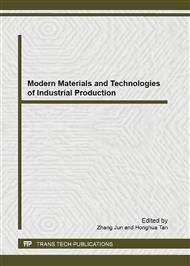p.126
p.131
p.135
p.140
p.146
p.152
p.157
p.163
p.171
Experimental Research on Mechanical Properties of Polypropylene Flexible Intermediate Bulk Container Base Materials
Abstract:
The Flexible Intermediate Bulk Container (FIBC) is a flexible transportation packaging container that is weaved by polyolefin plastic ribbon-like filament, which is widely used in the storage and transportation of granular and powder materials. When the FIBC was affected by environment factors synthetically under using, such as light, heat and air etc, it would come into degradation and its mechanical properties reduced. In this study, the basic mechanical properties of polypropylene FIBC base material were tested by tensile experiment and the reason of main base material mechanical properties difference between theoretical value and experimental value was analyzed. Based on the FIBC different using environments, the natural exposure experiment and high/low temperature experiments were carried out, we took tensile strength holding ratio and elongation holding ratio as evaluating indicator and analyzed law of influence of the different experiment condition on base material mechanical properties, which provided valuable reference for FIBC designing and manufacturing. Along with the experiment time increased, the color of base material changed from milk white to yellow slowly, the tensile strength and elongation reduced, the influencing grade was as follow: natural exposure>high temperature>low temperature. The results of natural exposure experiment showed that there was difference of anti-aging performance among the FIBC base material, the mechanical properties of woof fabric and belt reduced evidently, while others reduced slowly. For high (45°C)/low (-25°C) temperature experiments, the reduction of FIBC base materials mechanical properties were not obvious and woof fabric reduced a little faster comparatively.
Info:
Periodical:
Pages:
146-151
Citation:
Online since:
September 2013
Authors:
Price:
Сopyright:
© 2013 Trans Tech Publications Ltd. All Rights Reserved
Share:
Citation:


